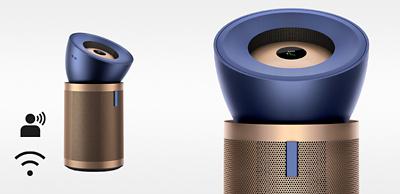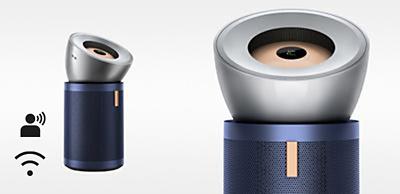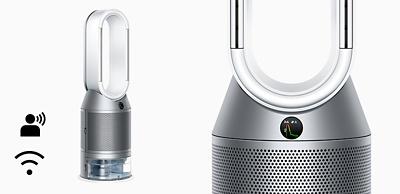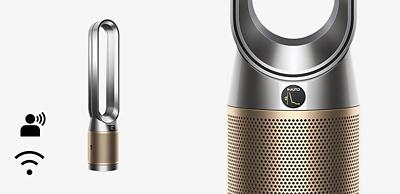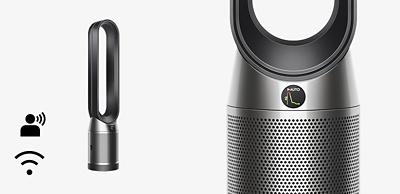Dyson on. Pollen off.
Dyson purifiers reduce your exposure to pollen, for a cleaner, healthier home.
Explore our indoor pollution guide to check which allergens could be hiding where you live.
Exclusive machines and offers
Exclusive machines and offers
Exclusive Dyson machines, unique colour options and special gift editions, only available from DysonCanada.ca and Dyson Demo Stores.
Free shipping and returns
Free shipping and returns
What are my shipping options?
Standard shipping: Free
Shipping via Purolator or Canada Post is free of change when ordering a machine from dysoncanada.ca and on all orders from a Dyson Demo Store. We aim to deliver the machine(s) within 2-7 business days, subject to availability. Please note that there are a small number of postal codes, usually in remote rural areas, to which we may not be able to deliver within this timescale.
Expedited shipping: $25
If you need your machine in a hurry, we also offer an expedited shipping option via Canada Post to major cities – your order will be delivered within 2 business days. Simply switch to the expedited shipping option in the checkout. Please note that there are a small number of postal codes, usually in remote rural areas, to which expedited shipping is not available.
Accessories and Spare Parts: $5.99
Shipping for accessories and spare parts is $5.99. Orders will be shipped within 2-7 business days via Canada Post.
How long does shipping take?
Estimated delivery times to major cities:
Cities |
Standard Shipping (Free) |
Expedited Shipping: ($25) |
To Toronto |
2-5 business days |
2 business days |
To Ottawa |
2-5 business days |
2 business days |
To Montreal |
2-5 business days |
2 business days |
To Quebec |
2-5 business days |
2 business days |
To Winnipeg |
3 -7 business days |
2 business days |
To Halifax |
3 -7 business days |
2 business days |
To Calgary |
3-7 business days |
2 business days |
To Edmonton |
4-8 business days |
2 business days |
To Saskatoon |
3-8 business days |
2 business days |
To Vancouver |
4-8 business days |
2 business days |
To St.John's |
5-10 business days |
2 business days |
When will my delivery arrive?
Delivery is Monday to Friday 9am – 6pm local time, not including statutory holidays. If a delivery cannot be completed (for example, if you’re not home), the carrier will leave a notification at your door indicating where you can pick up your order.
Dyson Canada will make every effort to process orders within this timeframe, but issues outside of our control, such as weather, may cause delays. Dyson Canada will not be held liable for shipping delays in those cases. To process orders within this timeframe, we may need to contact you to validate your credentials.
If ordering multiple products your order may be delivered in multiple shipments. This is to ensure that your order is delivered as soon as possible.
How do I track my order?
You will be sent a notice of shipment email with tracking information upon the shipment of your order.
Can I ship to a PO Box?
Shipping to PO boxes is not available due to package size restrictions.
Can I ship to a different address than my billing address?
Yes you can, however please note that different billing and shipping addresses may cause a slight delay in delivery time due to our order verification process.
What happens if I’m not home to receive my shipment?
Since a signature is always required, please try to make sure someone is home to sign for your package. The carrier will make one delivery attempt, and if nobody is available to sign for the package you'll have two options:
1) Contact your selected carrier to arrange for a second delivery attempt.
or
2) Pick up the package from your local Purolator depot or Canada Post office. In order to determine at which location your package is being held, look up the package using the tracking number shared via email or contact the carrier. Be sure to bring one piece of mail with your name on it and a government-issued ID when you pick up your order.
What happens if my order was ‘returned to sender’?
If your order is not picked up from your either your local Purolator depot or Canada Post office within the time listed on your delivery notice it will be returned to sender. In the event that this happens, please contact Dyson Canada via email at service@dysoncanada.ca or by phone at 1-877-397-6622.
How do I return a product?
Buy risk free with free 30-day returns.
Extended Holiday Returns: Any purchases made between the 1st of November 2025 and 25th of December 2025, can be returned up to the 31st of January 2026. Purchases made directly from www.dysoncanada.ca, Dyson Stores or Dyson helpline are eligible for a full money back. The Dyson outlet's refurbished machines are final sale and are not eligible to be returned.
Purchases made directly from www.dysoncanada.ca, Dyson Demo Stores, or Dyson helpline are eligible for a full money-back. The Dyson outlet's refurbished machines are final sale and are not eligible to be returned.
If you wish to return any product purchased from the Dyson Store within the first 30 days, please contact us prior to returning via email at service@dysoncanada.ca or by phone at 1-877-397-6622.
Dyson will cover the cost for the return shipping of any new machines. We will email you a pre-paid return shipping label. Simply print and affix it to the outside of your return shipment, and contact Purolator to arrange for a pick-up or you can drop it off at your local depot.
If you have any queries regarding your order, please contact service@dysoncanada.ca or call us at 1-877-397-6622.
Best price guaranteed
Best price guaranteed
Be confident that you are getting the best price on Dysoncanada.ca. If within 30 days of purchase you should find the same model advertised by an authorized Canadian Dyson retailer at a lower price, we’ll refund you the difference. Just contact our Customer Service team at 1-877-397-6622 to get started. Here’s what you’ll need to know:
• Product must be the exact same model number as it appears on DysonCanada.ca and in stock
• Proof of advertised price by an authorized dealer is required (Copy of Flyer or Website URL)
• Authorized dealers are limited to Amazon 1st party (ships and sold from Amazon.ca), Best Buy, Canadian Tire, Costco, Hudson's Bay, Home Hardware, London Drugs, Lowes, Rona, Rooms+Spaces, Sephora, Shoppers Drug Mart, TSC, Visions and Walmart.
• Product must be new and in original packaging. It cannot be reconditioned (refurbished), used, damaged, returned, open box, "close out", "clearance" or a demonstrator product.
• Product price must not be lower due to an advertising error or misprint
Dyson reserves the right to rescind this offer at any time and/or modify these terms and conditions as needed.
Pay by installments
Affirm (formerly known as PayBright) is one of Canada’s leading installment payment providers. When you use Affirm to pay at Dyson’s checkout, you can split your purchase into easy, automatic monthly payments. To use Affirm as your preferred payment choice at checkout.
1. Add items to your shopping cart as usual, and select Affirm as your payment method at checkout for orders between $100 and $15,000 (including taxes and shipping).
2. Get set up: Use your mobile phone number and email to set up your Affirm plan within 60 seconds. Subject to credit approval.
3. Confirm your payment plan with Affirm. Dyson will process and ship your order as usual.
4. Make monthly payments to Affirm while you enjoy your purchase.
Problematic particles – captured
Dyson purifiers and vacuums work together to capture and remove the microscopic particles which may cause allergies. When the machines are combined, they create a powerful double defence against pollen, dust, pet dander and mold.
-
Pollen
Released into the atmosphere when flowers come into bloom, with levels increasing over the warmer months. It can be brought into the home on clothes, hair and pets.
-
Dust
Dust can include skin cells, bacteria, and mold, and gets disturbed as you move around your home. Without an air purifier, it can stay airborne for up to 30 minutes.
-
Pet dander
Pet dander can include microscopic skin flakes and saliva, and it’s light enough to linger in the air for up to 30 minutes. As well as sticking to furniture, bedding and upholstery.
-
Mold
Mold grows on window frames, walls, textiles, plants and decaying food. Excess moisture causes it to spread and release spores. Without a purifier, mold spores can remain airborne for up to 30 minutes.
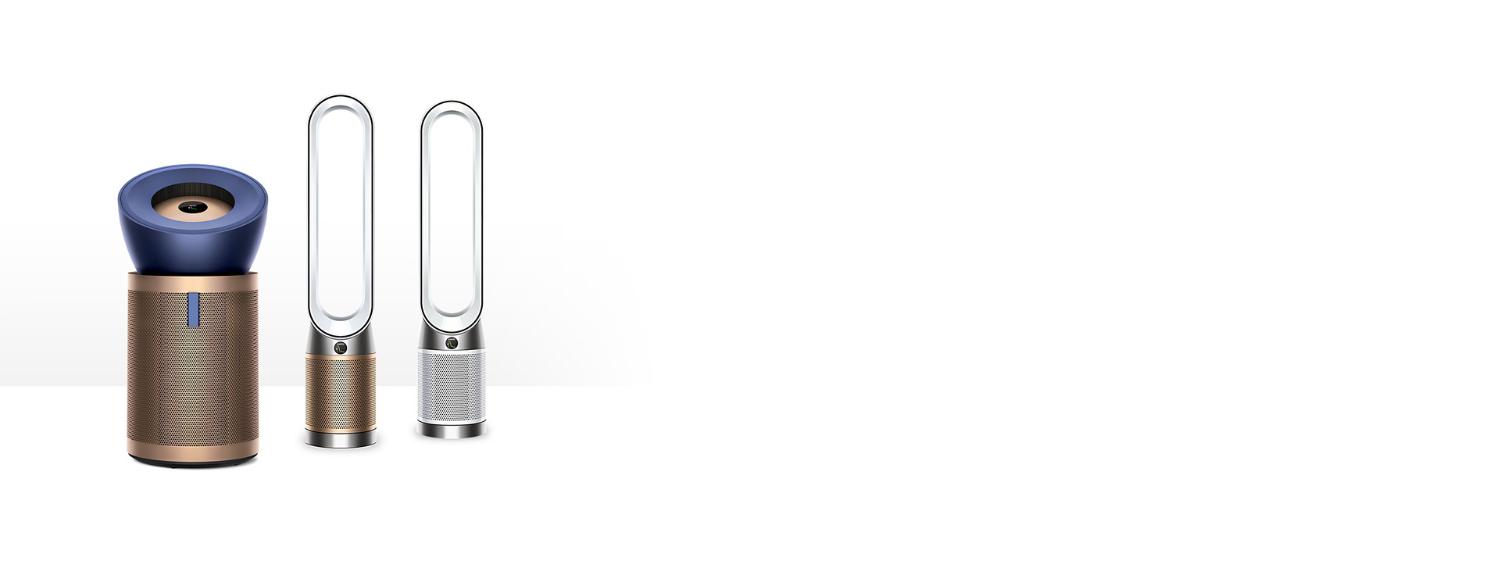
3 key things to look for in an air purifier
Automatic sensing, a fully-sealed machine and long-range air projection are key to effective air purification. That’s why they’re at the core of our technology. And why we’ve been testing them for generations.
Choose your model
Dyson Purifier Big+Quiet Formaldehyde BP04 (Prussian Blue/Gold)
1833
Dyson Purifier Big+Quiet Formaldehyde BP04 (Prussian Blue/Gold)
5
Star
1582
4
Star
121
3
Star
34
2
Star
19
1
Star
77
Projects air over 32 feet to purify a large space.¹ Quietly.
Detects and destroys formaldehyde, permanently.⁴ Removes gases and odours.²
Only at Dyson: exclusive K-Carbon filter technology captures 3x more NO₂ ³, and CO₂ sensor reports CO₂ levels in real-time.
3 accessories included
See all Hide-
Remote control
Curved and magnetized to store neatly on the machine.

-
K-Carbon filter
Captures 3x more NO₂. Genuine Dyson Activated K-Carbon Filter lifespan is every 2 years or when alerted by the MyDyson™ app.

-
HEPA filter
Genuine Dyson HEPA Filter lifespan is 5 years.

- Limited time offer. Terms and conditions apply.
- Bundle and save $300 on AM07 Dyson Cool™ tower fan. While supplies last.
- Limited time offer. Terms and conditions apply.
- Limited time offer. Terms and conditions apply.
Dyson Purifier Big+Quiet Formaldehyde BP03 (Bright Nickel/Prussian Blue)
1833
Dyson Purifier Big+Quiet Formaldehyde BP03 (Bright Nickel/Prussian Blue)
5
Star
1582
4
Star
121
3
Star
34
2
Star
19
1
Star
77
Projects air over 32 feet to purify a large space.¹ Quietly.
Detects and destroys formaldehyde, permanently.⁴
Remove gases and odours.²
3 accessories included
See all Hide-
Remote control
Curved and magnetized to store neatly on the machine.

-
HEPA filter
Genuine Dyson HEPA Filter lifespan is 5 years.

-
Activated carbon filter
Captures NO₂. Genuine Dyson Activated Carbon Filter lifespan is every 2 years or when alerted by the MyDyson™ app.

- Limited time offer. Terms and conditions apply.
- Bundle and save $300 on AM07 Dyson Cool™ tower fan. While supplies last.
- Limited time offer. Terms and conditions apply.
- Limited time offer. Terms and conditions apply.
Dyson Purifier Humidify+Cool PH2 De-NOx (White/Gold)
1145
Dyson Purifier Humidify+Cool PH2 De-NOx (White/Gold)
5
Star
896
4
Star
132
3
Star
29
2
Star
18
1
Star
70
Advanced air purification automatically captures 50% more NO₂. Even destroys formaldehyde.
Captures 99.97% of ultra-fine particles. Removes odors and gases. Purifies and hygienically humidifies the whole room. Also cools you in summer.
Only at Dyson: exclusive De-NOx technology captures 50% more NO₂ and White/Gold colourway.
2 accessories included
See all Hide-
Remote control
Curved and magnetized to store neatly on top of the machine

-
360° Combi HEPA + K-Carbon air purifier filter
Combined HEPA + K-Carbon filter

- Limited time offer. Terms and conditions apply.
- Bundle and save $300 on AM07 Dyson Cool™ tower fan. While supplies last.
- Limited time offer. Terms and conditions apply.
- Limited time offer. Terms and conditions apply.
Dyson Purifier Humidify+Cool PH03 (White/Silver)
245
Dyson Purifier Humidify+Cool PH03 (White/Silver)
5
Star
102
4
Star
50
3
Star
24
2
Star
23
1
Star
46
HEPA H13 purifier, humidifier and fan. Ideal for larger spaces.
Removes 99.97% of pollutants as small as 0.3 microns.
Automatically senses and displays real-time air quality, humidifies your whole room and helps keep skin hydrated.
2 accessories included
See all Hide-
Remote control
Curved and magnetized to store neatly on top of the machine.

-
360° Glass HEPA and Activated Carbon Filter
360 Combi Glass HEPA + Carbon air purifier 2-in-1 filter. We recommend replacing your filter every 12 months or when notified by your machine.

- Limited time offer. Terms and conditions apply.
- Bundle and save $300 on AM07 Dyson Cool™ tower fan. While supplies last.
- Limited time offer. Terms and conditions apply.
- Limited time offer. Terms and conditions apply.
Dyson Purifier Hot+ Cool HP2 De-NOx (White/Gold)
376
Dyson Purifier Hot+ Cool HP2 De-NOx (White/Gold)
5
Star
251
4
Star
58
3
Star
22
2
Star
14
1
Star
31
Advanced air purification automatically captures 50% more NO₂. Even destroys formaldehyde.
Captures 99.97% of ultra-fine particles. Removes odors and gases.
Purifies and heats the whole room evenly. Cools you in summer.
2 accessories included
See all Hide-
Remote Control
Curved and magnetized to store neatly on top of the machine.

-
360° Combi HEPA + K-Carbon air purifier filter
Combined HEPA + K-Carbon filter

Dyson Purifier Hot + Cool HP1 (Black/Nickel)
254
Dyson Purifier Hot + Cool HP1 (Black/Nickel)
5
Star
148
4
Star
32
3
Star
16
2
Star
13
1
Star
45
Heats your whole room and cools you, with premium air purification.
Captures gases and 99.95% of pollutants, automatically. For a healthier home.
Connect to the MyDyson™ app. Only at Dyson: Exclusive Black/Nickel colourway.
2 accessories included
See all Hide-
Remote control
Curved and magnetized to store neatly on the machine.

-
360° Glass HEPA and Activated Carbon Filter
360 Combi Glass HEPA + Carbon air purifier 2-in-1 filter. We recommend replacing your filter every 12 months or when notified by your machine.

- Limited time offer. Terms and conditions apply.
- Bundle and save $300 on AM07 Dyson Cool™ tower fan. While supplies last.
- Limited time offer. Terms and conditions apply.
- Limited time offer. Terms and conditions apply.
Dyson Purifier Hot + Cool HP1 (White)
254
Dyson Purifier Hot + Cool HP1 (White)
5
Star
148
4
Star
32
3
Star
16
2
Star
13
1
Star
45
2 accessories included
See all Hide-
Remote control
Curved and magnetised to store neatly on the machine.

-
360° Glass HEPA and Activated Carbon Filter
360 Combi Glass HEPA + Carbon air purifier 2-in-1 filter. We recommend replacing your filter every 12 months or when notified by your machine.

- Limited time offer. Terms and conditions apply.
- Bundle and save $300 on AM07 Dyson Cool™ tower fan. While supplies last.
- Limited time offer. Terms and conditions apply.
- Limited time offer. Terms and conditions apply.
Dyson Purifier Cool PC2 De-Nox (White/Gold)
580
Dyson Purifier Cool PC2 De-Nox (White/Gold)
5
Star
459
4
Star
67
3
Star
15
2
Star
10
1
Star
29
Advanced air purification automatically captures 50% more NO₂. Even destroys formaldehyde.
Captures 99.97% of ultra-fine particles. Removes odors and gases. Purifies the whole room evenly. Cools you with powerful airflow in summer.
Only at Dyson: exclusive De-NOx technology captures 50% more NO₂ and White/Gold colourway.
2 accessories included
See all Hide-
Remote Control

-
360° Combi HEPA + K-Carbon air purifier filter
Combined HEPA + K-Carbon filter

- Bundle and save $300 on AM07 Dyson Cool™ tower fan. While supplies last.
Dyson Purifier Cool Formaldehyde TP09 (Nickel/Gold)
2512
Dyson Purifier Cool Formaldehyde TP09 (Nickel/Gold)
5
Star
1890
4
Star
288
3
Star
96
2
Star
83
1
Star
155
2 accessories included
See all Hide-
Remote Control

-
360° Glass HEPA and Activated Carbon Filter
360 Combi Glass HEPA + Carbon air purifier 2-in-1 filter. We recommend replacing your filter every 12 months or when notified by your machine.

- Bundle and save $300 on AM07 Dyson Cool™ tower fan. While supplies last.
Dyson Purifier Cool TP07 (Black/Nickel)
1705
Dyson Purifier Cool TP07 (Black/Nickel)
5
Star
1281
4
Star
202
3
Star
81
2
Star
50
1
Star
91
2 accessories included
See all Hide-
Remote control
Curved and magnetized to store neatly on the machine

-
360° Glass HEPA and Activated Carbon Filter
360 Combi Glass HEPA + Carbon air purifier 2-in-1 filter. We recommend replacing your filter every 12 months or when notified by your machine.

- Limited time offer. Terms and conditions apply.
- Bundle and save $300 on AM07 Dyson Cool™ tower fan. While supplies last.
- Limited time offer. Terms and conditions apply.
- Limited time offer. Terms and conditions apply.
Dyson Purifier Cool PC1 (White)
337
Dyson Purifier Cool PC1 (White)
5
Star
208
4
Star
44
3
Star
26
2
Star
29
1
Star
30
2 accessories included
See all Hide-
Remote control
Curved and magnetized to store neatly on top of the machine.

-
360° Glass HEPA and Activated Carbon Filter
360 Combi Glass HEPA + Carbon air purifier 2-in-1 filter. We recommend replacing your filter every 12 months or when notified by your machine.

- Limited time offer. Terms and conditions apply.
- Bundle and save $300 on AM07 Dyson Cool™ tower fan. While supplies last.
- Limited time offer. Terms and conditions apply.
- Limited time offer. Terms and conditions apply.
Promotion
Whole-home deep cleaning
As well as purifying the air in your home, keep surfaces as clean as possible by vacuuming allergens transferred from clothes and pets. The advanced suction power of a Dyson vacuum, combined with the high purification rate of a Dyson purifier, can help you maintain a cleaner, healthier home.
-
Dyson purifiers
As well as capturing 99.97% of particles as small as PM0.3³, Dyson purifiers can cool you in summer, heat a room in winter, and humidify when needed.
-
Dyson vacuum cleaners
Dyson cordless vacuums are engineered for whole-home, deep cleans. With a filtration system that captures allergens and seals in 99.99% of microscopic particles as small as 0.3 microns.⁴
Frequently asked questions
Dyson vacuum filters are engineered to trap microscopic particles and allergens. Our sophisticated filtration system captures 99.97% of allergens as small as 0.3 microns⁴ – and expels clean air. HEPA filtration goes a step further and the standard demands not only for the final post-motor filter in a vacuum to be HEPA-grade, but every single filter and seal throughout the machine. HEPA filtration is available on the Dyson V15 Detect™ vacuum and traps 99.95% per cent of microscopic particles and allergens as small as 0.1 microns.⁵
If pet hair and allergens are a problem for you, it’s recommended to use a vacuum with extra strong suction power, and to vacuum your home on a regular basis. Don’t allow dust, pet hair and dander to accumulate. It’s also important to vacuum your mattress and upholstery. Thanks to new, unique technology, Dyson cordless vacuums can detect and pick up even the tiniest dust particles and hair.
Discover Dyson
-
How to manage allergies
It’s not just exposure to pollen in the green countryside that contains allergens. City pollution in urban areas can also be a problem. Read more about how to keep allergens out and create a pure environment inside.
-
How to remove household dust
Dust can accumulate in hard-to-reach places like the corners of walls, skirting boards, light fixtures and backs of wardrobes. Regular vacuuming of surfaces and improving air quality can reduce this.
-
Take control of pet allergies
Our furry friends can bring plenty of joy, but also a few microscopic allergens into your home. Read more about our useful tips for managing pet dander and allergies.
Exclusive machines and offers
Exclusive machines and offers
Exclusive Dyson machines, unique colour options and special gift editions, only available from DysonCanada.ca and Dyson Demo Stores
Free shipping and returns
Free shipping and returns
What are my shipping options?
Standard shipping: Free
Shipping via Purolator or Canada Post is free of change when ordering a machine from dysoncanada.ca and on all orders from a Dyson Demo Store. We aim to deliver the machine(s) within 2-7 business days, subject to availability. Please note that there are a small number of postal codes, usually in remote rural areas, to which we may not be able to deliver within this timescale.
Expedited shipping: $25
If you prefer to check out with Expedited Shipping, please contact our Customer Care team through the Live Chat icon below, or at 1-877-397-6622 and they will be happy to assist you.
Accessories and Spare Parts: $5.99
Shipping for accessories and spare parts is $5.99. Orders will be shipped within 2-7 business days via Canada Post.
How long does shipping take?
Estimated delivery times to major cities:
Cities |
Standard Shipping (Free) |
Expedited Shipping: ($25) |
To Toronto |
2-5 business days |
2 business days |
To Ottawa |
2-5 business days |
2 business days |
To Montreal |
2-5 business days |
2 business days |
To Quebec |
2-5 business days |
2 business days |
To Winnipeg |
3 -7 business days |
2 business days |
To Halifax |
3 -7 business days |
2 business days |
To Calgary |
3-7 business days |
2 business days |
To Edmonton |
4-8 business days |
2 business days |
To Saskatoon |
3-8 business days |
2 business days |
To Vancouver |
4-8 business days |
2 business days |
To St.John's |
5-10 business days |
2 business days |
When will my delivery arrive?
Delivery is Monday to Friday 9am – 6pm local time, not including statutory holidays. If a delivery cannot be completed (for example, if you’re not home), the carrier will leave a notification at your door indicating where you can pick up your order.
Dyson Canada will make every effort to process orders within this timeframe, but issues outside of our control, such as weather, may cause delays. Dyson Canada will not be held liable for shipping delays in those cases. To process orders within this timeframe, we may need to contact you to validate your credentials.
If ordering multiple products your order may be delivered in multiple shipments. This is to ensure that your order is delivered as soon as possible.
How do I track my order?
You will be sent a notice of shipment email with tracking information upon the shipment of your order.
Can I ship to a PO Box?
Shipping to PO boxes is not available due to package size restrictions.
Can I ship to a different address than my billing address?
Yes you can, however please note that different billing and shipping addresses may cause a slight delay in delivery time due to our order verification process.
What happens if I’m not home to receive my shipment?
Since a signature is always required, please try to make sure someone is home to sign for your package. The carrier will make one delivery attempt, and if nobody is available to sign for the package you'll have two options:
1) Contact your selected carrier to arrange for a second delivery attempt.
or
2) Pick up the package from your local Purolator depot or Canada Post office. In order to determine at which location your package is being held, look up the package using the tracking number shared via email or contact the carrier. Be sure to bring one piece of mail with your name on it and a government-issued ID when you pick up your order.
What happens if my order was ‘returned to sender’?
If your order is not picked up from your either your local Purolator depot or Canada Post office within the time listed on your delivery notice it will be returned to sender. In the event that this happens, please contact Dyson Canada via email at service@dysoncanada.ca or by phone at 1-877-397-6622.
How do I return a product?
Buy risk free with free 30-day returns
Extended Holiday Returns: Any purchases made between the 1st of November 2025 and 25th of December 2025, can be returned up to the 31st of January 2026. Purchases made directly from www.dysoncanada.ca, Dyson Stores or Dyson helpline are eligible for a full money back. The Dyson outlet's refurbished machines are final sale and are not eligible to be returned.
Purchases made directly from www.dysoncanada.ca, Dyson Demo Stores, or Dyson helpline are eligible for a full money-back. The Dyson outlet's refurbished machines are final sale and are not eligible to be returned.
If you wish to return any product purchased from the Dyson Store within the first 30 days, please contact us prior to returning via email at service@dysoncanada.ca or by phone at 1-877-397-6622.
Dyson will cover the cost for the return shipping of any new machines. We will email you a pre-paid return shipping label. Simply print and affix it to the outside of your return shipment, and contact Purolator to arrange for a pick-up or you can drop it off at your local depot.
If you have any queries regarding your order, please contact service@dysoncanada.ca or call us at 1-877-397-6622.
Price match promise
Best price guaranteed
Be confident that you are getting the best price on Dysoncanada.ca. If within 30 days of purchase you should find the same model advertised by an authorized Canadian Dyson retailer at a lower price, we’ll refund you the difference. Just contact our Customer Service team at 1-877-397-6622 to get started. Here’s what you’ll need to know:
• Product must be the exact same model number as it appears on DysonCanada.ca and in stock
• Proof of advertised price by an authorized dealer is required (Copy of Flyer or Website URL)
• Authorized dealers are limited to Amazon 1st party (ships and sold from Amazon.ca), Best Buy, Canadian Tire, Costco, Hudson's Bay, Home Hardware, London Drugs, Lowes, Rona, Rooms+Spaces, Sephora, Shoppers Drug Mart, TSC, Visions and Walmart.
• Product must be new and in original packaging. It cannot be reconditioned (refurbished), used, damaged, returned, open box, "close out", "clearance" or a demonstrator product.
• Product price must not be lower due to an advertising error or misprint
Dyson reserves the right to rescind this offer at any time and/or modify these terms and conditions as needed.
Pay by installments
Affirm (formerly known as PayBright) is one of Canada’s leading installment payment providers. When you use Affirm to pay at Dyson’s checkout, you can split your purchase into easy, automatic monthly payments. To use Affirm as your preferred payment choice at checkout.
1. Add items to your shopping cart as usual, and select Affirm as your payment method at checkout for orders between $100 and $15,000 (including taxes and shipping).
2. Get set up: Use your mobile phone number and email to set up your Affirm plan within 60 seconds. Subject to credit approval.
3. Confirm your payment plan with Affirm. Dyson will process and ship your order as usual.
4. Make monthly payments to Affirm while you enjoy your purchase.
Owner support


